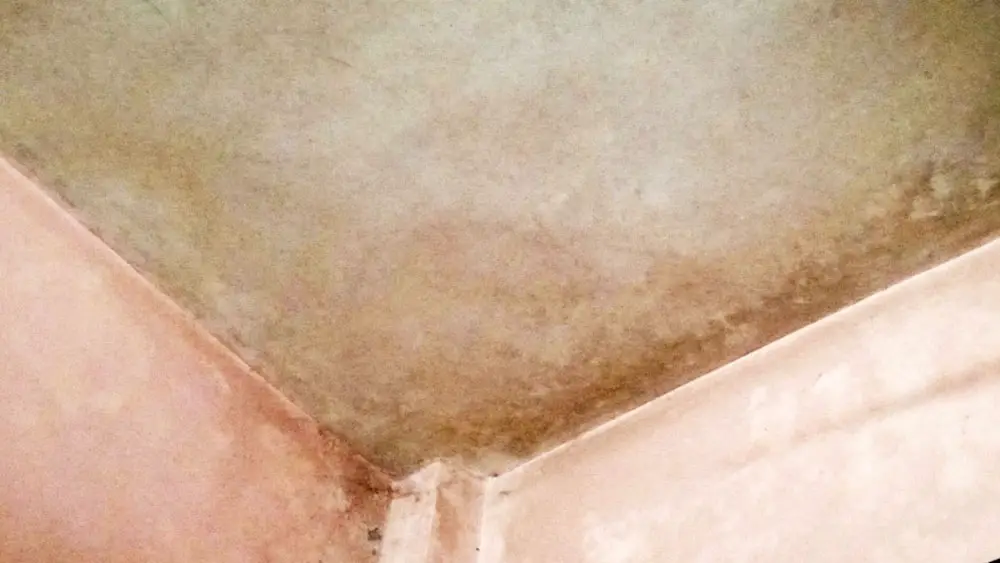Ghosting on walls and ceilings can make it hard to keep your living area clean and nice to look at. Ghosting, which is when unsightly stains or smudges show out of nowhere, can make a room look creepy and dirty. But don’t worry, because there are good ways to deal with it. By using a few simple but smart cleaning methods, you can get rid of these ghosts from your walls and ceilings and bring back your home’s charm and beauty.
I have learned a lot about ghosting, from what causes it to what tools and goods to use to clean it. In this blog post, I’ll give you step-by-step steps and useful tips to help you get rid of ghosts and bring back the beauty of your home.
Why Do Ghost Marks Show Up on Walls and Ceilings?
There are many things that can cause ghost marks on walls and ceilings. One of the main reasons is that soot and dust build-up on surfaces. Most of the time, these bits are made by burning candles, wood, or food. Soot and dust settle on the walls and ceilings over time, leaving ghostly marks that are easier to see in places with less airflow.
The growth of ghosting can also be caused by condensation. When warm, humid air comes into touch with cooler surfaces, like exterior walls or windows, condensation forms. The moisture in the air brings tiny particles, like dust and dirt, that can stick to a wet surface and leave ghosting marks.
Lack of air is another thing that can lead to ghosting. If there isn’t enough airflow, there can be areas of still air where dust and soot can settle more easily. This is often seen in places where airflow is limited, like behind furniture, in corners, or near windows.
In some cases, ghosting lines can be a sign of mold growth below the surface. Mold grows best in places with a lot of wetness, and if water builds up on the walls and ceilings, it can give mold the perfect place to grow. Mold growth not only makes the surfaces look bad, but it can also be dangerous to your health if you don’t take care of it.
Understanding what causes ghosting marks is important if you want to clean them well and keep them from happening. Ghosting on walls and ceilings can be greatly reduced by fixing the problems that cause it, such as dust buildup, condensation, and air problems.
How to Get Rid of Ghosts from Walls and Ceilings
There are many things that can cause ghosting, such as soot, dust, humidity, and even mold growth. If you don’t do anything about it, ghosting can make your walls and ceilings look dirty and bad. In this guide, we’ll show you all the steps you need to take to get rid of ghosting and make your walls and ceilings look like new again.

Step 1: Get the things you need
Before you start cleaning up the ghosts on your walls and ceilings, you’ll need these things:
- A brush or broom with soft bristles
- Attachment for a vacuum cleaner that has a brush
- Cloths or brushes made of microfibers
- Mild soap or a mix for cleaning walls
- Warm water
- Bucket
- Rubber gloves
- Ladder or step stool (if needed)
- Safety goggles (if needed)
Step 2: Get the area ready
Start by setting up the space where you will be working. Take out any chairs or other things that might get in the way of your cleaning. Put down drop cloths or plastic sheets to keep drips or spills from ruining the floor or furniture. Open windows or doors to make sure there is enough airflow while cleaning.
Step 3: Dust Dry
Clean the walls and ceilings gently with a soft-bristled brush or broom to get rid of loose dust and dirt. You don’t want to damage the paint or wallpaper by pressing too hard. You can also use a vacuum with a brush attachment to get rid of dust easily.
Step 4: Vacuuming
Next, clean the walls and ceilings to get rid of any loose dust or dirt that is still there. Make sure the vacuum cleaner is set to a low pressure level to keep the surface from getting damaged. Pay close attention to the walls and ceilings, especially the corners, edges, and patterns with a lot of detail.
Step 5: Try out the cleaning solution
If you are using a commercial cleanser or cleaner to clean your walls, it is best to test it on a small, hidden area first. Put a small amount of the solution on a cloth or sponge, and then rub it gently into the area you want to test. Wait a few minutes to see if anything bad happens or if the color changes. If the area you tested looks good, you can use the cleaning solution.
Step 6: Make the cleaning solution
If you decide to use a cleaning solution, make sure to follow the directions on the bottle. Most of the time, this means diluting the formula in a bucket of warm water. Be careful not to make the solution too strong, or it could damage the surfaces of the wall or ceiling.
Step 7: Clean the spots
Dip a microfiber cloth or sponge into the cleaning solution, squeeze out any extra liquid, and gently rub the affected areas in a circle motion. Start with a small area and slowly move to the rest of the walls and ceilings. Don’t press too hard, because it could damage the paint or wallpaper. Do the same thing for each ghost mark.
Step 8: Rinse with clean water
After spot cleaning, rinse the walls and ceilings with clean water on a separate microfiber cloth or sponge. This will help get rid of any cleaning solution leftovers. Make sure to squeeze out any extra water so that it doesn’t drip.
Step 9: Let the surfaces dry out
Let the walls and ceilings dry on their own, or pat them gently with a clean, dry microfiber cloth. Don’t use things with too much heat, like hair dryers, because they can cause paint or wallpaper to peel.
Step 10: Measures to stop it
To stop ghosts from appearing in the future, keep your space clean and well-ventilated. Dust and clean the walls and ceilings often, especially in places where ghosts are likely to appear. Use fans, open windows, or put in a dryer to make the air move better. Make sure the HVAC system is well taken care of and that the filters are changed regularly to keep dust and soot from building up.
Different Ways to Get Rid of Ghosting on Walls and Ceilings
Even though the last guide gave detailed steps for how to clean ghosting on walls and ceilings, there are other ways you can try based on how bad the ghosting is and what you like. Here are a few more ideas you can think about:
Solution with Vinegar
Ghosting marks can be removed with vinegar, which is a natural cleaner. In a spray bottle, mix equal amounts of white vinegar and warm water. Spray the solution on the damaged areas and let it sit for a few minutes. Scrub the marks gently with a soft cloth or sponge, then rinse with clean water and dry the surfaces well.
Baking Soda Paste
Another natural cleaner that can help get rid of ghosting is baking soda. Mix baking soda with a small amount of water until it gets thick and makes a paste. Apply the paste to the spots, and then gently scrub the marks with a soft cloth or sponge. Rinse the area with clean water and let it dry.
Cleaning by steam
If you want a more powerful method, you could use a steam cleaner. Walls and ceilings with ghost marks can be easily cleaned with steam. Follow the directions for how to use the steam cleaner, and be careful not to soak the surfaces too much. Use a clean cloth or sponge to gently wipe away the loosening residue.
Help from experts
If the ghosting is bad or keeps happening no matter what you do, it might be best to call an expert. Professional cleaners use special tools and methods to get rid of ghosting marks that won’t go away. They can look at the situation, figure out what’s causing the ghosts, and come up with a thorough cleaning plan that fits your needs.
Safety should always come first, and you should try any cleaning method on a small, unnoticeable area first before using it on the whole surface. Also, things like regular dusting, good airflow, and controlling the humidity can help make ghosting less likely to happen again.
How Can Ghosting be Differentiated from Other Types of Stains or Discoloration?
Knowing the difference between ghosting marks and other spots or discolorations on walls and ceilings can help you choose the best way to clean them. Here are some key things that set ghosting apart from other problems:
Location: Ghost marks usually show up in certain places, like near windows, in corners, or behind furniture. They often follow the way things or buildings in the room are arranged. Other kinds of marks or spots may be spread out more randomly over the surface.
Shape and Pattern: Usually, ghosting marks have a clear shape or pattern that looks like an object or an image. They can look like shadows or the same shape over and over. On the other hand, some stains or spots may not have a clear design and look like blotches, spots, or streaks.
Lack of Surface Roughness: Ghosting lines often appear on smooth surfaces that don’t have any rough spots that can be seen. Ghosting doesn’t usually cause the surface to bend, bubble, or fall apart like mold growth or water damage does.
Resistance to Cleaning: Ghosting marks can be harder to get rid of than other stains with standard cleaning methods. Normal wiping or cleaning may not be enough to get rid of ghosting because the particles that make the marks tend to stick to the surface. This makes ghosting different from spots or discolorations that are easier to get rid of.
Repeating: Ghosting marks tend to come back even after you clean them. If the marks stay in the same place or design after you clean the surface, it’s likely ghosting. After being cleaned well, other stains or spots might not come back.
Environmental Factors: Things in the environment, like poor air movement or changes in temperature, can cause ghosting marks. If the marks are more noticeable in places where humidity is likely to happen or where there is a lot of dust and soot, it means that ghosting is happening.
By thinking about these things, you can tell ghosting lines apart from other kinds of stains or spots. If you aren’t sure what the marks are, it’s best to talk to a professional who can correctly identify the problem and suggest the best ways to clean or fix it.
FAQs
Can marks that look like ghosts on my walls and ceilings hurt my health?
Most ghosting marks are not dangerous to your health. But the things that cause ghosting, like too much dust or mold, can be bad for your health. Dust particles can make breathing problems worse, set off allergies, or irritate the lungs. If mold is growing, it can send out spores that can make it hard to breathe and cause allergic reactions. To keep a healthy indoor environment, it is important to deal with these issues.
Is ghosting more likely to happen with certain types of paint or finishes?
Ghosting can happen more often with some kinds of paint or finishes. Ghosting shows up more on flat or matte finishes than on satin or semi-gloss finishes. This is because surfaces with a flat finish are more porous and can trap particles more easily. Using paints with higher sheens and finishes that can be cleaned can help make ghosting lines less obvious.
Can ghost lines be removed without hurting the paint or wallpaper?
Yes, ghosting lines can usually be cleaned up without hurting the paint or wallpaper if you use the right cleaning methods. Use gentle cleaning methods, stay away from rough materials, and test any cleaning solution on a small, hidden area before putting it on the whole surface. Be careful not to put too much pressure on the paint or wallpaper, as this can damage it.
How often should I clean my walls and ceilings to keep ghosts from coming into my home?
Ghosting can be stopped with regular upkeep. Walls and ceilings should be dusted and vacuumed often, at least once every few months or more often in high-traffic areas. This helps keep dust and soot from building up, which makes ghosting less likely to happen.
Can ghosts come back after being cleaned?
Even after cleaning, ghosting marks tend to come back. This is because things like dust buildup or condensation may still be going on underneath. Even though a thorough cleaning can briefly get rid of the marks, they will come back if the causes are not fixed. Taking preventive steps like improving ventilation, controlling moisture, and doing regular upkeep can help reduce the chances of ghosts coming back.
Can I use bleach to get rid of smudges?
Most of the time, bleach is not a good way to get rid of ghosting marks. Bleach is a strong chemical that could hurt the paint or wallpaper if it is not used properly. Also, bleach might not work to get rid of ghosting because it mostly gets rid of organic marks and not particles like dust or soot. It is best to use light detergents or cleaners made just for walls, which are safer for surfaces.
Can ghost marks on wallpaper be taken away?
Yes, you can clean wallpaper to get rid of ghost marks. But extra care is needed to keep damage from happening. Start by using a dry duster or a vacuum with a soft brush attachment to get rid of fine dust and dirt. Test a small, hidden area with a light detergent solution or a cleaner made just for wallpaper to make sure it doesn’t stain or damage the wallpaper. Use a soft cloth or brush to clean the ghosting marks, being careful not to soak the wallpaper too much. Use a clean, wet cloth to wipe it down, then pat it dry.
Should I paint my walls and ceilings again to get rid of ghosting?
You might not have to repaint to get rid of ghost marks unless the paint is badly damaged or you want a different look. Most ghost marks can be removed without having to redo if you use the right cleaning methods. But if the ghosting marks keep coming back or the paint is in bad shape, you might want to repaint.
Can a dehumidifier help stop ghosts from appearing?
Yes, using a dehumidifier to control the humidity in your home can help stop ghosts from appearing. High humidity is a common cause of ghosting because it makes condensation and mold grow. A dehumidifier can help reduce the chances of ghosting by getting rid of extra moisture in the air.
Can ghosting marks be taken care of by skilled cleaning services?
Yes, ghosting lines can be taken care of by a professional cleaning service. They have the right tools, knowledge, and cleaning solutions to get rid of stubborn ghosts. Professional cleaners can figure out how bad the ghosting is, find out what’s causing it, and give you a thorough cleaning option that fits your needs. If you can’t get rid of ghosting marks on your own or if the problem keeps coming back, you might want to call an expert.
Final Thoughts
It takes time and care to get rid of ghosting on walls and ceilings. If you follow the steps in this guide, you’ll be able to get rid of ghosting marks and bring back the beauty of your home. Always test cleaning products on a small area first, and make sure to take all the safety measures you need to. With regular upkeep and precautions, you can make it less likely that ghosting will come back in the future.







